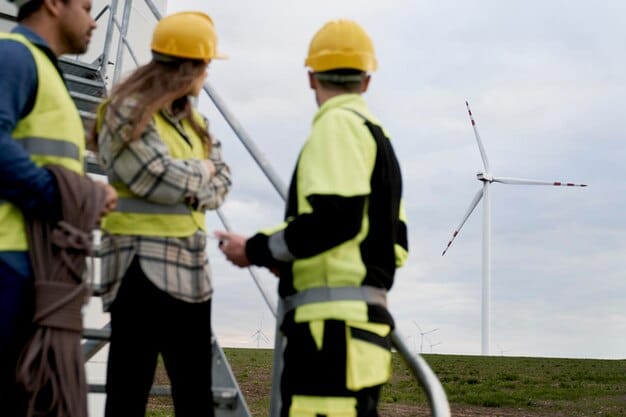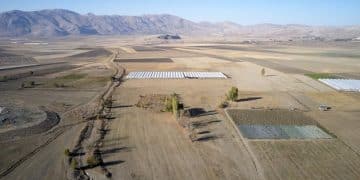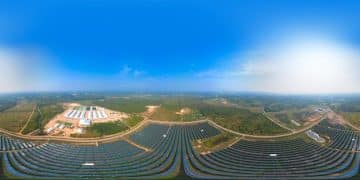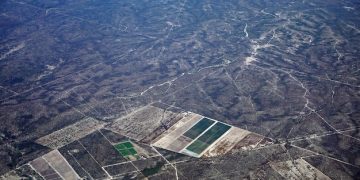How to Attract and Retain Skilled Workers in the US Clean Energy Sector

The US energy sector can attract and retain skilled workers to meet the growing demand for clean energy jobs by focusing on competitive compensation, comprehensive training programs, fostering a diverse and inclusive workplace, offering opportunities for career advancement, and promoting work-life balance.
The US energy sector is facing a surge in demand for skilled workers as the transition to clean energy accelerates. Understanding how can the US energy sector attract and retain skilled workers to meet the growing demand for clean energy jobs is crucial for sustainable growth.
The Growing Demand for Skilled Workers in the US Clean Energy Sector
The US clean energy sector is experiencing unprecedented growth, creating a high demand for skilled workers. This surge is driven by factors such as government incentives, technological advancements, and increasing awareness of climate change. Understanding the factors driving this increased demand is essential for addressing workforce challenges.
Government Initiatives and Investments
Government policies, such as tax incentives and renewable energy standards, are spurring significant investment in clean energy projects. These initiatives create numerous job opportunities across various sectors.
Technological Advancements
Innovations in solar, wind, and energy storage technologies require a workforce skilled in engineering, data science, and advanced manufacturing. These technological shifts are reshaping the skills landscape.
- Job creation in renewable energy sectors.
- Demand for specialized skills in emerging technologies.
- The role of federal and state policies in workforce development.
Addressing the growing demand for skilled workers in the clean energy sector requires a multi-faceted approach that includes strategic workforce planning, targeted training programs, and proactive recruitment strategies.

Offering Competitive Compensation and Benefits Packages
Competitive compensation and benefits packages are crucial in attracting and retaining skilled workers in the clean energy sector. Companies need to benchmark their offerings against industry standards to ensure they are competitive.
Salary Benchmarking
Regularly review and adjust salaries to remain competitive with other sectors and companies. Use industry surveys and data to benchmark compensation levels.
Comprehensive Benefits
Offer a comprehensive benefits package that includes health insurance, retirement plans, paid time off, and other perks. These benefits enhance the overall value proposition for employees.
- Importance of competitive salaries in attracting top talent.
- The role of health insurance and retirement plans in employee satisfaction.
- Additional benefits such as flexible work arrangements and professional development opportunities.
Investing in Comprehensive Training and Apprenticeship Programs
Investing in comprehensive training and apprenticeship programs is essential for building a skilled workforce in the clean energy sector. These programs provide hands-on experience and technical knowledge necessary for success.
Developing Targeted Training Programs
Create training programs that address specific skill gaps in the industry. Partner with vocational schools, community colleges, and universities to develop relevant curricula.
Establishing Apprenticeship Opportunities
Offer apprenticeship programs that combine classroom instruction with on-the-job training. These programs provide valuable experience and help individuals develop the skills needed for long-term careers.
By investing in comprehensive training and apprenticeship programs, the clean energy sector can develop a pipeline of skilled workers who are equipped to meet the challenges and opportunities of the industry.

Fostering a Diverse and Inclusive Workplace Culture
Creating a diverse and inclusive workplace culture is crucial for attracting and retaining talent in the clean energy sector. Diverse teams bring different perspectives and ideas, leading to innovation and better problem-solving.
Promoting Diversity and Inclusion Initiatives
Implement diversity and inclusion initiatives that promote equal opportunities for all employees. This includes targeted recruitment efforts, mentorship programs, and employee resource groups.
Creating a Supportive Work Environment
Foster a supportive work environment where employees feel valued, respected, and empowered to contribute their best work. This includes providing feedback, recognizing achievements, and addressing concerns promptly.
- The benefits of diversity in innovation and problem-solving.
- Strategies for promoting inclusion in the workplace.
- The importance of equal opportunities and fair treatment.
Building a diverse and inclusive workplace culture not only attracts top talent but also enhances employee engagement, productivity, and retention.
Providing Opportunities for Career Advancement and Professional Development
Offering opportunities for career advancement and professional development is critical for retaining skilled workers in the clean energy sector. Employees who see opportunities for growth are more likely to stay with their companies.
Creating Clear Career Pathways
Establish clear career pathways that outline the steps employees can take to advance within the organization. This includes providing training, mentorship, and advancement opportunities.
Supporting Professional Development
Support professional development by providing access to conferences, workshops, and certifications. This helps employees stay up-to-date with the latest technologies and best practices.
- The role of career development in employee retention.
- The impact of professional development on skills enhancement.
- Strategies for creating a culture of continuous learning.
Promoting Work-Life Balance and Employee Well-being
Promoting work-life balance and employee well-being is essential for attracting and retaining skilled workers in the clean energy sector. Employees who have a healthy work-life balance are more productive and engaged.
Offering Flexible Work Arrangements
Provide flexible work arrangements such as telecommuting, flextime, and compressed workweeks. These arrangements allow employees to better manage their personal and professional responsibilities.
Prioritizing Employee Well-being
Prioritize employee well-being by offering wellness programs, mental health resources, and supportive policies. This demonstrates a commitment to the health and happiness of employees.
- The benefits of work-life balance for employee productivity.
- Strategies for promoting mental health and well-being in the workplace.
- The impact of supportive policies on employee engagement.
By promoting work-life balance and employee well-being, the clean energy sector can create a positive and supportive work environment that attracts and retains top talent.
Collaborating with Educational Institutions and Industry Partners
Collaborating with educational institutions and industry partners is crucial for addressing workforce challenges in the clean energy sector. These collaborations help align training programs with industry needs and provide valuable networking opportunities.
Partnering with Universities and Colleges
Establish partnerships with universities and colleges to develop curricula that meet the needs of the clean energy industry. This includes offering internships, research projects, and guest lectures.
Engaging with Industry Associations
Engage with industry associations to stay informed about workforce trends and best practices. This includes participating in conferences, attending workshops, and collaborating on research projects.
- The role of partnerships in aligning training programs with industry needs.
- The benefits of industry associations in workforce development.
- Strategies for fostering collaboration between educational institutions and industry partners.
| Key Point | Brief Description |
|---|---|
| 💰 Compensation | Offer competitive salaries and benefits packages. |
| 📚 Training | Invest in comprehensive training and apprenticeship programs. |
| 🤝 Culture | Foster a diverse and inclusive workplace culture. |
| 🚀 Growth | Provide opportunities for career advancement. |
FAQ
▼
The increasing demand is due to government incentives, technological advancements, and growing awareness of the importance of clean energy to mitigate climate change, leading to more investments and growth in the sector.
▼
Key strategies include offering competitive compensation and benefits, comprehensive training, promoting a diverse and inclusive workplace, and providing opportunities for career advancement and professional development.
▼
Work-life balance is crucial. Flexible work arrangements and wellness programs can significantly boost employee satisfaction and retention by allowing employees to manage their personal and professional lives effectively.
▼
Educational institutions are key partners in developing curricula that align with industry needs. Collaborations through internships, research projects, and guest lectures prepare students for the clean energy workforce.
▼
Diversity and inclusion foster innovation by bringing different perspectives and ideas. Inclusive environments also ensure that all employees feel valued and can contribute their best work, leading to higher productivity.
Conclusion
Attracting and retaining skilled workers in the US clean energy sector requires a comprehensive approach that addresses compensation, training, workplace culture, career development, and work-life balance. By focusing on these key areas, the industry can build a strong and sustainable workforce to meet the growing demand for clean energy jobs.





